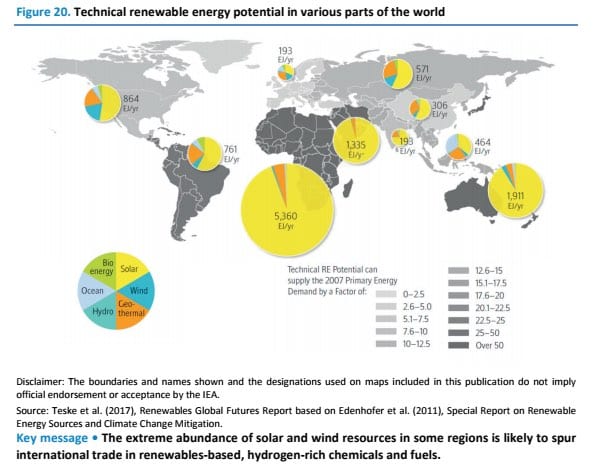A new report from the International Energy Agency has confirmed what is becoming increasingly obvious to many in the Australian market: that the business case for substituting grid electricity with self-generated renewable power is proving more and more persuasive – not just for home owners and businesses, but for major industrial energy users.
The newly published IEA report, titled Renewable Energy for Industry, finds that clean energy resources including solar, hydro and and wind power have enormous potential for use in industrial processes, offering cheaper sources of power and an opportunity for greater emissions reductions.
And Australia – among other regions where renewable energy resources are considered to be “especially abundant” – offers some of the largest and highest-quality potential for industry to make the switch.
“The recent rapid cost reductions in solar photovoltaics (PV) and wind power may enable new options for greening the industry, either directly from electricity or through the production of hydrogen (H)-rich chemicals and fuels,” the report says.
In places like Australia, it notes, “the cost of hydro, solar and wind power can fall below $US30/MWh ($A39/MWh) and supply an electricity load with high load factors, particularly when combined.”
That figure is less than half current wholesale market prices. And it reflects on Gupta’s assessment that solar and storage will cut costs for the steel works by around 40 per cent.
Of particular benefit, however, is the direct integration of renewables into industrial assets, which the report says promises to reward businesses “beyond the benefits they would derive from the simple purchase of renewable power.”
These benefits include hedging against fuel and grid price volatility; improved energy supply reliability; increased productivity; and additional revenue opportunities through sales of excess energy to the grid, heat networks, or to other industries.
This will come as no surprise to the likes of British billionaire Sanjeev Gupta, who is in the process of transforming his newly acquired Australian steel business into a renewable energy powerhouse, via massive investments in solar and storage that will knock 40 per cent off his electricity costs.
Gupta last month confirmed that he would build 1GW of dispatchable renewables in and around Whyalla, where his major steel plant is located, including solar, battery storage, pumped hydro and demand management.
He is also looking to follow this up with varying mixes and scale of renewables and storage to power the company’s steel operations in Melbourne, Sydney and Newcastle, which he plans to power 100 per cent by renewable energy.
And the report, too, touches specifically benefits of processing iron ores directly in areas with excellent renewable resources.
“Indeed, several of the world’s largest iron ore deposits are located in southern Brazil, western China, Mauritania, northern Chile, South Africa and Western Australia, and are relatively close to areas with excellent resources,” it says.
“Processing it into steel on the spot …would keep it hot and thus save energy in arc furnaces and benefit from lower electricity costs.”
And it doesn’t stop there. Korean zinc refiner Sun Metals began building a 116MW solar farm in May this year – south of Townsville, in Queensland – which the company expects will provide around one-third of electricity demand for its refinery business, while also underpinning its plans for expansion.
“This is a large refining company that views solar as better alternative to their current power solution,” said Jack Curtis, regional manager Asia Pacific for First Solar, the company commissioned to build the Sun Metals plant.
“This project represents the viability of the commercial and industrial solar market in Australia and the growing trend of major energy consumers owning and operating renewable energy assets.”
And other industries are jumping on board. The report notes that in Australia, international fertiliser company Yara has announced plans to build a pilot solar ammonia plant in the Pilbara region of Western Australia, which could be in service as early as 2019.
According to Ammonia Energy, the cost-competitiveness of renewable ammonia with natural gas ammonia was a major topic of the a recent industry conference in Rotterdam.
“Thanks to the recent cost reductions of solar and wind technologies, ammonia production in large-scale plants based on electrolysis of water can compete with ammonia production based on natural gas, in areas with world-best combined solar and wind resources,” the IEA’s Cédric Philibert – who also authored the Renewable Energy for Industry report – told the conference.
In this latest IEA report, Philibert notes that Siemens is also running a pilot ammonia plant with a 20MW wind farm. The industrial giant has also, reportedly, been “in discussions” to develop a massive solar field in the Australian desert that “would produce 1 million tonnes of ammonia per day, roughly twice today’s total global production capacity, for export as a carbon-free energy commodity.”









